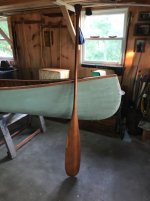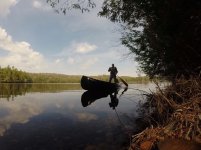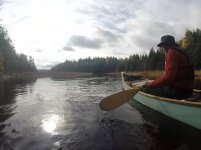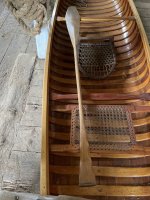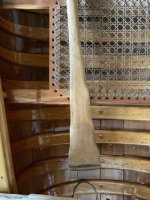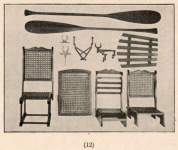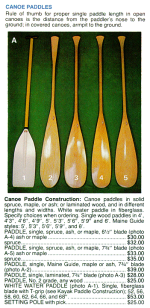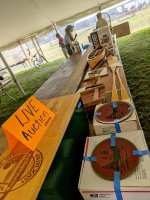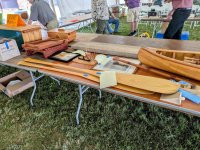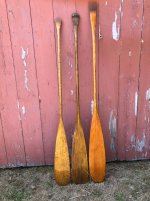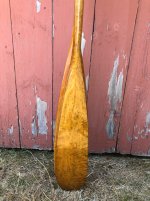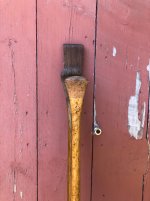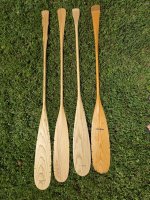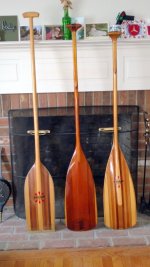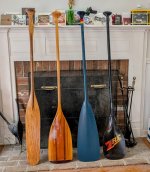First off, what is it? Over thirty years ago I was introduced to paddling a canoe standing up with a six foot paddle. The guy who introduced me to it had been a Maine guide, so I had assumed a Maine Guide paddle was a six foot long beaver tail, like what he used. Fast forward about 20 or 25 years and I became familiar with the "Northwoods Paddle" with its elongated grip and thought, maybe this is a Maine Guide paddle.
A few years ago at the WCHA Assembly I picked up a six foot beavertail with a pear shaped grip and an Old Town label on it. It was the exact opposite of the paddle I was looking for. I was looking for a six footer with a long narrow blade and thin shaft that was lighter than my six foot ash beavertails. This paddle had an oversized blade and a fat shaft but seemed light for its size so I took a chance on it. It turned out that I loved it. The first thing I noticed was how much water (boat) it pulled. My thought was, "wow, this thing will get me across the lake with less strokes.
Getting back to what the Maine Guide paddle is. I remembered seeing a vintage paddle a few years before, it had the same oversized blade as the one I recently purchased, but was only 60 inches. It was an Old Town paddle and I think may have been labeled a "guide" but I'm not sure. I would have bought it if I realized its significance, but I didn't and I already had too many 60 inchers. Now looking back and wondering what makes a Maine Guide paddle, it's not the length or the type of grip, but the size of the blade. This makes sense, because in the tradition of the Maine guides they would take out clients that did not help with the paddling. They would need a bigger paddle, including the blade. to compensate for that. Coincidently the paddle paired perfectly with my 20' EM White, which was also popular with the Maine guides.
The blade on my guide paddle is 8.5 inches wide and about thirty inches long. It's probably only an inch wider and longer than my other beavertails, but it is significantly bigger and noticeably does more when it comes to moving a boat. Besides that feeling of moving the boat better than anything else, I've also done things with it that I had never done with another paddle. Once when fishing I had to use my paddle with one hand to keep my boat on course. It was a windy day and when I picked up the paddle to change course, instead of reaching and putting the blade in the water I just held it up and caught enough wind to do what was needed. I was pretty impressed with this and did a little experimenting. I wanted to see if in a tail wind I could catch some wind and pick up speed with it. It did, and not only that, I could control the direction of my drift. If I held the paddle out on one side of the boat it would turn towards the other side. Unfortunately I haven't been using the paddle lately as it sustained some damage and I like it too much to chance damaging it more. It also has the downside of requiring more effort to use the an ordinary beavertail. Although it is a beavertail it is a different paddle when it comes to it's capabilities and I thought it worth mentioning.
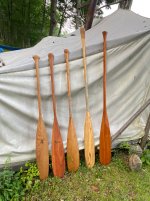
It is the paddle furthest to the right
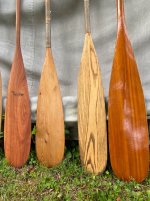
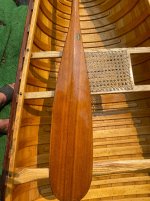
A few years ago at the WCHA Assembly I picked up a six foot beavertail with a pear shaped grip and an Old Town label on it. It was the exact opposite of the paddle I was looking for. I was looking for a six footer with a long narrow blade and thin shaft that was lighter than my six foot ash beavertails. This paddle had an oversized blade and a fat shaft but seemed light for its size so I took a chance on it. It turned out that I loved it. The first thing I noticed was how much water (boat) it pulled. My thought was, "wow, this thing will get me across the lake with less strokes.
Getting back to what the Maine Guide paddle is. I remembered seeing a vintage paddle a few years before, it had the same oversized blade as the one I recently purchased, but was only 60 inches. It was an Old Town paddle and I think may have been labeled a "guide" but I'm not sure. I would have bought it if I realized its significance, but I didn't and I already had too many 60 inchers. Now looking back and wondering what makes a Maine Guide paddle, it's not the length or the type of grip, but the size of the blade. This makes sense, because in the tradition of the Maine guides they would take out clients that did not help with the paddling. They would need a bigger paddle, including the blade. to compensate for that. Coincidently the paddle paired perfectly with my 20' EM White, which was also popular with the Maine guides.
The blade on my guide paddle is 8.5 inches wide and about thirty inches long. It's probably only an inch wider and longer than my other beavertails, but it is significantly bigger and noticeably does more when it comes to moving a boat. Besides that feeling of moving the boat better than anything else, I've also done things with it that I had never done with another paddle. Once when fishing I had to use my paddle with one hand to keep my boat on course. It was a windy day and when I picked up the paddle to change course, instead of reaching and putting the blade in the water I just held it up and caught enough wind to do what was needed. I was pretty impressed with this and did a little experimenting. I wanted to see if in a tail wind I could catch some wind and pick up speed with it. It did, and not only that, I could control the direction of my drift. If I held the paddle out on one side of the boat it would turn towards the other side. Unfortunately I haven't been using the paddle lately as it sustained some damage and I like it too much to chance damaging it more. It also has the downside of requiring more effort to use the an ordinary beavertail. Although it is a beavertail it is a different paddle when it comes to it's capabilities and I thought it worth mentioning.

It is the paddle furthest to the right



